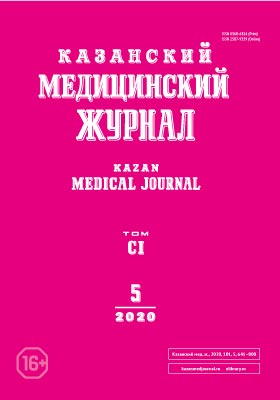The effect of the distance from the pyloric sphincter and size of the calibration tube on postoperative outcomes of the laparoscopic sleeve gastrectomy
- Authors: Omarov TI1,2, Bayramov NY.1, Huseynova MR2, Zeynalov NA1
-
Affiliations:
- Azerbaijan Medical University
- Modern Hospital
- Issue: Vol 101, No 5 (2020)
- Pages: 669-676
- Section: Theoretical and clinical medicine
- Submitted: 25.01.2020
- Accepted: 15.04.2020
- Published: 27.10.2020
- URL: https://kazanmedjournal.ru/kazanmedj/article/view/19135
- DOI: https://doi.org/10.17816/KMJ2020-669
- ID: 19135
Cite item
Abstract
Aim. To study of the effect of the diameter of the calibration tube and the distance from the pyloric sphincter on the outcomes of the laparoscopic sleeve gastrectomy.
Methods. The study included 945 (915 women) patients with a body mass index 51.5±9 kg/m2. The average age of the patients was 53.5±8.5 years. The patients were divided into 2 groups by the type of laparoscopic surgery: in the first group (n=463), a 36 Fr calibration tube was used, the distance from the pyloric sphincter was 4–6 cm; in the second group (n=482), a 32 Fr calibration tube was used, the distance from the pyloric sphincter was 2–3 cm. The main comparison criteria was the percentage of body weight loss in the first 6 and 12 months, and an additional comparison criteria was the of concomitant diseases progress in postoperative and the existence of complications.
Results. A comparative analysis showed that the first group in the first 6 months lost 59±3% of its initial body weight, while in 12 months — 71±4%; in the second group, 73±3 and 87±3% of the initial weight, respectively. Concomitant diseases in the first group decreased by 70–80% by the 6th month after surgery and by 85–96% by the 12th month. In the 2nd group, similar remission with improvement was between 84 and 94% at the 6th month, and remained the same at the 12th month.
Conclusion. The results of the study show that in laparoscopic sleeve gastrectomy with a calibration tube diameter 32 Fr and a distance of 2–3 cm from the pyloric sphincter, compared to a calibration tube diameter 36 Fr or more and a distance of 4–6 cm from the pyloric sphincter, a body weight loss faster and more effective with earlier remission of concomitant diseases, while the number of complications is comparable.
Full Text
About the authors
T I Omarov
Azerbaijan Medical University; Modern Hospital
Author for correspondence.
Email: taryelomerov@gmail.com
Azerbaijan, Baku, Azerbaijan; Baku, Azerbaijan
N Yu Bayramov
Azerbaijan Medical University
Email: taryelomerov@gmail.com
Azerbaijan, Baku, Azerbaijan
M R Huseynova
Modern Hospital
Email: taryelomerov@gmail.com
Azerbaijan, Baku, Azerbaijan
N A Zeynalov
Azerbaijan Medical University
Email: taryelomerov@gmail.com
Azerbaijan, Baku, Azerbaijan
References
- Berger E.R., Clements R.H., Morton J.M. et al. The impact of different surgical techniques on outcomes in laparoscopic sleeve gastrectomies: the first report from the Metabolic and Bariatric Surgery Accreditation and Quality Improvement Program (MBSAQIP). Ann. Surg. 2016; 264: 464–473. doi: 10.1097/SLA.0000000000001851.
- El Geidie A., El Hemaly M., Hamdy E. et al. The effect of residual gastric antrum size on the outcome of laparoscopic sleeve gastrectomy: a prospective randomized trial. Surg. Obes. Relat. Dis. 2015; 11: 997–1003. doi: 10.1016/j.soard.2014.12.025.
- English W.J., De Maria E.J., Brethauer S.A. et al. American Society for Metabolic and Bariatric Surgery estimation of metabolic and bariatric procedures performed in the United States in 2016. Surg. Obes. Relat. Dis. 2018; 14: 259–263. doi: 10.1016/j.soard.2017.12.013.
- Gagner M., Deitel M., Erickson A.L., Crosby R.D. Survey on laparoscopic sleeve gastrectomy (LSG) at the Fourth International Consensus Summit on Sleeve Gastrectomy. Influence of antrum size on gastric emptying and weight-loss outcomes after laparoscopic sleeve gastrectomy (preliminary analysis of a randomized trial). Surg. Endosc. 2018; 32: 2739–2745. doi: 10.1007/s00464-017-5972-4.
- Garay M., Balague C., Rodriguez-Otero C. et al. Influence of antrum size on gastric emptying and weight-loss outcomes after laparoscopic sleeve gastrectomy (preliminary analysis of a randomized trial). Surg. Endosc. 2018; 32: 2739–2745. doi: 10.1007/s00464-017-5972-4.
- Ilhan Ece, Huseyin Yilmaz, Husnu Alptekin et al. Comparative effectiveness of laparoscopic sleeve gastrectomy on morbidly obese, super-obese, and super-super obese patients for the treatment of morbid obesity. Obes. Surg. 2018; 28: 1484–1491. doi: 10.1007/s11695-017-3053-3.
- Omer Avlanmis, Riza Gurhan Isil, Busra Burcu. Effect of resection distance from pylorus on weight loss outcomes in laparoscopic sleeve gastrectomy. Obes. Surg. doi: 10.1007/s11695-019-03923-3.
- Cal P., Deluca L., Jakob T., Fernández E. Laparoscopic sleeve gastrectomy with 27 versus 39 Fr bougie calibration: a randomized controlled trial. Surg. Endosc. 2016; 30: 1812–1815. doi: 10.1007/s00464-015-4450-0.
- Spivak H., Rubin M., Sadot E. et al. Laparoscopic sleeve gastrectomy using 42-French versus 32-French bougie: the first-year outcome. Obes. Surg. 2014; 14 (7): 1090–1093. doi: 10.1007/s11695-014-1199-9.
- Weiner R.A., Weiner S., Pomhoff I. et al. Laparoscopic sleeve gastrectomy—influence of sleeve size and resected gastric volume. Obes. Surg. 2007; 17 (10): 1297–1305. doi: 10.1007/s11695-007-9232-x.
- Yormaz S., Yilmaz H., Ece I. et al. Midterm clinical outcomes of antrum resection margin at laparoscopic sleeve gastrectomy for morbid obesity. Obes. Surg. 2017; 27: 910–916. doi: 10.1007/s11695-016-2384-9.
Supplementary files








